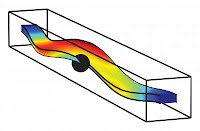 | New JILA apparatus measures fast nanoscale motions. View clip in avi format nist.gov/nanobeammodel.avi |
The new device measures the wiggling of the beam, or, more precisely, the space between it and an electrically conducting point just a single atom wide, based on the speed of electrons “tunneling” across the gap. The work is the first use of an “atomic point contact,” the business end of an STM, to sense a nanomechanical device oscillating at its “resonant” frequency, where it naturally vibrates like a tuning fork. JILA is a joint venture of the National Institute of Standards and Technology (NIST) and the University of Colorado at Boulder.
Although the JILA technique, described in the March 2 issue of Physical Review Letters,* is not necessarily as precise as more complex and much colder methods of measuring very fast motions of ultra-small devices, it incorporates several innovative attributes. These include the ability to minimize unwanted random electronic “noise” as well as to measure the random shaking of the beam caused by back-action or recoil (similar to what happens when a gun is fired). This level of sensitivity is possible because the atomic point contact acts as an amplifier for these otherwise imperceptible factors, and the gold beam is tiny and floppy enough—just 100 nanometers (nm) thick, and 5.6 micrometers long by 220 nm wide—to respond to single electrons.
The new method involves bringing the sharp point within one nanometer of the gold beam. A current is applied through the point across the gap, until an increase in resistance indicates that electrons are “tunneling” across the gap (a phenomenon observed only at atomic dimensions). The size of the gap is then monitored based on variations in the current. The beam’s undulations were measured with tens to hundreds of times greater precision than a typical STM result. That’s because the oscillations are measured using microwave electronics, which are much faster than the audio frequency technology typically used with STMs, thus enabling greater precision. The microwave measurement technique could potentially be applied to STMs.
The work was supported in part by NIST and the National Science Foundation.
* N.E. Flowers-Jacobs, D.R. Smith and K.W. Lehnert. Intrinsic noise properties of atomic point contact displacement detectors. Physical Review Letters. 98, 096804 (2007). ###
Contact: Laura Ost laura.ost@nist.gov 303-497-4880 National Institute of Standards and Technology (NIST)
Technorati Tags: nanofibers or Nanoscientists and Nano or Nanotechnology and nanoparticles or Nanotech and nanotubes or nanochemistry and nanoscale or nanowires and Nanocantilevers or nanometrology and University of Colorado at Boulder or National Institute of Standards and Technology and scanning tunneling microscopes or nanoscale motion detector














No comments:
Post a Comment